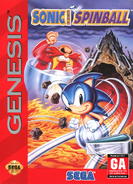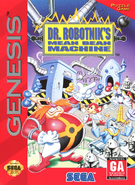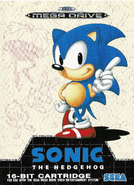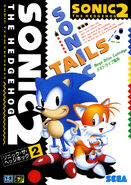Information in this article is about real-life people, companies, and objects, which do not relate to the in-universe Sonic series. |

|
When rewriting sections, remember to adhere to our Manual of Style.
|
- For the object in the Archie Comics, see Mega Drive.
The Sega Mega Drive (メガドライブ Mega Doraibu?) is a video game system released by Sega in the late 1980s. It was sold under the name Sega Genesis in North America as Sega was unable to secure legal rights to the "Mega Drive" name in that region.[2] The Mega Drive was Sega's third move in attempt to dominate the home console market and was the successor to the Sega Master System.
The Mega Drive is part of the fourth generation era of video game consoles and the first of its generation to achieve notable market share in Europe and North America. It was a direct competitor of NEC's PC Engine (which was released one year earlier and had a better success in Japan) and the Super Nintendo Entertainment System (which was released two years later). The Sega Mega Drive began production in Japan in 1988 and ended with the last official title were being released in 2002 in Brazil.[3]
With a lifespan of fourteen years and 41.9 million units sold, it became Sega's most successful console. The console has a legacy with certain games available and regarded as the starter of Sonic the Hedgehog series as well.
Sonic games
- Flicky
- Sonic the Hedgehog
- Sonic Eraser
- Sonic the Hedgehog 2
- Sonic the Hedgehog Spinball
- Dr. Robotnik's Mean Bean Machine
- Sonic the Hedgehog 3
- Wacky Worlds Creativity Studio
- Sonic & Knuckles
- Sonic Compilation
- Mega 6 Volume 3
- Sonic 3D Blast
- 6-Pak
Characters Introduced
Box artwork gallery
United States
| Gallery |
|---|
Europe and United Kingdom
| Gallery |
|---|
Japan
| Gallery |
|---|
History
Although the Sega Master System was a success in Europe, and later also Brazil, it failed to ignite much attention in the North American or Japanese markets, which, by the mid-to-late 1980s, were both dominated by Nintendo's large market shares.[4][5][6] Meanwhile in the arcades, the Sega System 16 had become a success. Hayao Nakayama, Sega's CEO at the time, decided to make its new home system utilize a similar 16-bit architecture.[7] The final design was eventually also used in the Mega-Tech, Mega-Play and System-C arcade machines. Any game made for the Mega Drive hardware could easily be ported to these systems.[8]
The first name Sega considered for its console was the MK-1601, but it ultimately decided to call it the "Sega Mega Drive". The name was said to represent superiority and speed, with the new and powerful Motorola 68000 processor in mind.[9] Sega used the name Mega Drive for the Japanese, European, Asian, Australian and Brazilian versions of the console. The North American version went by the name "Genesis" due to a trademark dispute.[2]
Launch
The Mega Drive was released in Japan on 29 October 1988,[10] almost exactly a year after the release of NEC PC Engine and the same year as the release of TurboGrafx 16 in North America.
In 1987, Sega announced a North American release date for the system (under the name of Sega Genesis) of January 9, 1989.[11] Sega initially attempted to partner with Atari Corporation for distribution of the console in the US, but the two could not agree to terms and Sega decided to do it themselves.[12] Sega was not able to meet the initial release date and United States sales began on 14 August 1989 in New York City and Los Angeles. The Genesis was released in the rest of North America later that year.[13]
The European release was on 30 November 1990. Following on from the European success of the Sega Master System, the Mega Drive became a very popular console in Europe. Unlike in other regions where the Nintendo Entertainment System had been the dominant platform, the Sega Master System was the most popular console in Europe at the time. In the United Kingdom, the most well known of Sega's advertising slogans was "To be this good takes AGES, to be this good takes SEGA". Some of these adverts employed adult humor and innuendo with sentences like "The more you play with it, the harder it gets" displayed with an illustration of the waggling of a joystick.[14] A prominent figure in the European marketing was the "Sega Pirate", a talking one-eyed skull that starred in many TV adverts with a generally edgy and humorous attitude. Since the Mega Drive was already two years old at the release in Europe, the many games available at launch were naturally more in numbers compared to the launches in other regions. The ports of arcade titles like Altered Beast, Golden Axe and Ghouls 'n Ghosts, available in stores at launch, provided a strong image of the console's power to deliver an arcade-like experience.[15] The arrival of Sonic the Hedgehog in 1991 was just as successful as in North America, with the new Sega mascot becoming popular throughout the continent.[15]
In Brazil, the Mega Drive was released by Tec Toy in 1990, only a year after the Brazilian release of the Sega Master System. Tec Toy also ran the Internet service Sega Meganet service in Brazil as well as producing games exclusively for the Brazilian market.[16]
Add-ons
- .

The Sega 32X
Sega Mega Drive has two optional add-ons, the Sega CD and Sega 32X. Sega CD plays a high-quality CD-ROM using a 1x Optical Disc Drive while increasing audio and visual capabilities over stock Mega Drive. Sega CD was originally released as the Mega-CD in Japan, 1991 as a part of the interactive movie and CD-based video game system.
Sega 32X works as an "enhancement" over a stock Mega Drive console with additional 32-bit processor to process more complex graphical tasks. Sega 32X was released almost the same time as Sega Saturn was released, in 1994.
End of support and third-party licensing
The Mega Drive was supported until 1997 in Europe, when Sega announced it was dropping support for it.[10] It was discontinued along with its predecessor, the long-lived Sega Master System, to allow Sega to concentrate on its newer console, the Saturn. The Mega Drive's add-ons, the Mega CD and 32X, were also both discontinued at this point, having been the same general failures they were in the other regions.[17]
In 1997, Sega licensed the Mega Drive to Majesco so that its could re-release the console.[18] Majesco began re-selling millions of formerly unsold cartridges at a budget price together with the second model of the Genesis, until it later released a third version of it. The last commercially licensed release in North America was Frogger, released in 1998.[19]
In Brazil, licensed Mega Drive remains on the market since 1990s. The latest version, called "Mega Drive Guitar Idol", comes with two six-button joypads and a guitar controller with five Fret fret buttons. The Guitar Idol game contains a mix of Brazilian and international songs. The console has 87 built-in games, including some new ones from Electronic Arts, originally cellphone games: FIFA 2008, Need for Speed Pro Street, The Sims 2 and Sim City.
Backwards-compatibility

Sega Power Base Converter
One of the key design features of the console is its backwards compatibility with Sega's previous console, the Sega Master System. The 16-bit design is based upon the 8-bit design, albeit enhanced and extended in many areas. In order to achieve backwards compatibility, the Master System's central processor and sound chip (the Zilog Z80[9] and SN76489 respectively) are included in the Mega Drive, and the Mega Drive's Video Display Processor (VDP) is capable of the Master System's VDP's mode 4 (though it cannot run in modes 0, 1, 2, or 3).
As the cartridge slot is of a different shape, Sega released the Power Base Converter, a separate device that sits between a Master System cartridge and the Mega Drive's cartridge slot. The Power Base Converter does not contain any Master System components, instead functioning as a pass-through device. The converter contains a top slot for cartridge-based games along with a front slot for card-based games, as well as the 3-D glasses adapter. When a Master System game is inserted, the system puts the Z80 in control, leaving the Mega Drive's main 68000 processor idle.[9]
In Japan the device is known as the "Mega Adapter". The PAL variant is called the "Master System Converter".[20]
The Power Base Converter is not fully compatible with the redesigned Mega Drive 2, though certain modifications could nullify that issue. A second version, the "Master System Converter II", was released to address this problem. This second version adapter was produced in a far smaller quantity and only released in Europe.[9]
The only game which does not work with this device is F-16 Fighting Falcon.[21]
Peripherals
The original three-button controller, marked with the Genesis logo.
The standard Mega Drive controller features three main buttons and a "start" button usually used for pausing mid-game. The controller itself has a distinctive rounded shape.[22] Sega later released a six-button version which is slightly smaller and features three more face buttons, similar to the design of buttons on arcade fighting games.[22]
A number of other peripherals for the Mega Drive were released that add extra functionality. The Menacer Light Gun was developed in response to the Super Scope for the SNES and is only compatible with the Menacer 6-game cartridge and a few other games.[23] The Sega Mouse and Sega Mega Mouse were also released for the Mega Drive, the latter being available in North America while the other served the Japanese and European markets. A foam-covered bat called the BatterUP and the TeeVGolf golf club were both released for the Mega Drive and SNES and provide support for similar games.
Sega Nomad
The Sega Nomad (also called Sega Genesis Nomad or just Nomad) was a handheld game system sold for the North American consumer market which played Mega Drive/Genesis game cartridges. The system was similar to the Japanese Sega Mega Jet, but featured a built-in color screen; the Mega Jet needed a separate monitor.
The Nomad was never officially released in PAL territories such as Europe and Australia, though the unit retained its PAL/NTSC switch on the internal board. It was released in Japan after a delay as the Mega Jet was already being sold in Japanese retail stores. The Nomad is one of the few Sega systems that can play most games regardless of region without an adapter. Its codename during development was Project Venus, as per Sega's policy at the time of codenaming their systems after planets.
Game library
The Nomad does not have its own game library, but instead plays Genesis games. At the time of its launch, the Nomad had over 500 games available for play. However, no pack-in title was included. The Nomad can boot unlicensed, homebrew, and bootleg games made for the Genesis.
Some earlier third-party titles have compatibility issues when played on the Nomad, but can be successfully played through the use of a Game Genie. Likewise, due to its lack of compatibility with any of the Genesis' add-ons, it is unable to play any games for the Sega Master System, Sega CD, or Sega 32X. The Nomad employs two different regional lockout methods, physical and software, but methods have been found to bypass these restrictions
Sega Mega Jet
The Sega Mega Jet was another handheld version of the Sega Mega Drive. It was rented for use aboard Japan Airlines flights. The device lacked its own screen but could play Mega Drive cartridges when connected to a small armrest monitor used on JAL flights. The unit featured a directional pad on the left side and six buttons on the right, similar to the layout of a game controller. There was a second joypad port on the bottom of the Mega Jet for multiplayer games.
A consumer version of Mega Jet was released by Sega of Japan on March 10, 1994 at the cost US $123. It was essentially the same as the unit that was used on JAL flights, meaning that it still lacked a screen and couldn't be powered without an AC adapter. Other than the addition of a mono DIN plug cord and the necessary AC adapter, no other additions or improvements were made.
Four games for the flight were available, including Super Monaco GP, and Sonic the Hedgehog. However, since the unit accepted standard Mega Drive cartridges, passengers could bring in and use their own. The Mega Jet was marketed in Japan as a portable Mega Drive, and was available in limited quantities in department stores.
The Mega Jet eventually became the basis for the Sega Nomad released exclusively in the United States in 1995, a portable Mega Drive with a backlit screen.
Trivia
- Japanese Sega Mega Drive cartridges have a different shape and will not fit in either Genesis or PAL region Mega Drive cartridge slot. Japanese Mega Drive systems have a piece of plastic that slides in a place of the cartridge when the power switch is turned on, inserting a Genesis cart will make it impossible to turn on a Japanese MD. Minor modifications to the plastic locks in the systems will bypass the regional locks.
- However, the console main board was designed with language and frequency jumper sets which originally activated features in the same ROM for the different regions, this feature was later used to enable software-based regional locks that display warning messages that prevent the game from being played. Switches placed instead of the jumpers will bypass the locks.
- In region-locked games, if there is a multiple language feature, it can be changed with the switches after the game has booted-up.
- There are over 900 games released for the Mega Drive across seven major regions: Japan, USA, Europe, Australasia, Korea, Asia, and Latin America.
- The console is mentioned in a couple of songs rapped by "The Game" and "Busta Rhymes".
- In Lego Dimensions, after Sonic follows Eggman through a portal he battles Robo Sonic, Mecha Sonic, and Metal Sonic. After he is finished fighting Metal Sonic explodes and hits the portal device causing 3 portals to open, and the first model of the Sega Mega Drive flies out one of those portals.
References
- ↑ Sega Mega Drive/Genesis Console Information. Console Database. Base Media. Retrieved on 4 June 2018.
- ↑ 2.0 2.1 Szczepaniak, John (September 2006). Retroinspection: Sega Mega Drive. Retro Gamer. Retrieved on 29 March 2018.
- ↑ Show do Milhão. Guardiana.
- ↑ Steven L. Kent (2001). The Ultimate History of Video Games: The Story Behind the Craze that Touched our Lives and Changed the World. Roseville, California: Prima Publishing. pp. 303, 360. ISBN 0-7615-3643-4.
- ↑ Pettus, Sam (2004-07-07). Genesis: A New Beginning. www.sega-16.com. Retrieved on 2008-03-06.
- ↑ Planet Dreamcast staff . Sega History. http://www.planetdreamcast.com. IGN Entertainment. Retrieved on 2007-10-18.
- ↑ 9.0 9.1 9.2 9.3 Christoph Bolitz
. Sega Mega Drive information. www.skillreactor.org. Retrieved on 2008-04-01. Cite error: Invalid
<ref>tag; name "sreac" defined multiple times with different content Cite error: Invalid<ref>tag; name "sreac" defined multiple times with different content Cite error: Invalid<ref>tag; name "sreac" defined multiple times with different content - ↑ 10.0 10.1 Console Database Staff
. Sega Mega Drive/Genesis Console Information. http://www.consoledatabase.com. Console Database/Dale Hansen. Retrieved on 2007-10-18. Cite error: Invalid
<ref>tag; name "ConsoleInfo" defined multiple times with different content - ↑ Sheff, David (1993). Game Over: How Nintendo Zapped an American Industry, Captured Your Dollars, and Enslaved Your Children. New York: Random House. pp. 352. ISBN 0-679-40469-4.
- ↑ Steven L. Kent (2001). The Ultimate History of Video Games: The Story Behind the Craze that Touched our Lives and Changed the World. Roseville, California: Prima Publishing. pp. 401. ISBN 0-7615-3643-4.
- ↑ Kent, Steven L. (2001). The Ultimate History of Video Games. Roseville, California: Prima Publishing. pp. 404–405. ISBN 0-7615-3643-4.
- ↑ SEGA'S BIZARRE EARLY 1990S VIZ ADVERTS. http://www.ukresistance.co.uk (2006). Retrieved on 2007-10-20.
- ↑ 15.0 15.1 McFerran, Damien "Damo"
(2007). Hardware Focus - Sega Megadrive /Genesis. http://www.vc-reviews.com. Retrieved on 2007-10-19. Cite error: Invalid
<ref>tag; name "MegaDriveLaunch" defined multiple times with different content - ↑ Tiago Tex Pine (2008-02-26). How Piracy can Break an Industry - the Brazilian Case. Retrieved on 2008-04-14.
- ↑ Blake Snow (2007-07-30). The 10 Worst-Selling Consoles of All Time. GamePro. Retrieved on 2008-05-20.
- ↑ Sega (Majesco) Genesis 3. www.pelikonepeijoonit.net. Retrieved on 6 March 2006.
- ↑ Game Rankings Recent Releases list of Genesis. CNET Networks, Inc.. Retrieved on 2008-04-03.
- ↑ Old-Computers.com Staff . Mega Drive II. http://www.old-computers.com. Retrieved on 2007-10-18.
- ↑ Master System Converter Instruction Manual, p. 7.
- ↑ 22.0 22.1 Michael Drake, Adrian Lees, and Jeffrey Lee . Pico Drive Mega Drive Background. Retrieved on 2008-04-03.
- ↑ John Scalzo (2007-11-19). Zap!: A History of Light Gun Games (Special) @ Gaming Target. Retrieved on 2008-04-03.
- ↑ 24.0 24.1 Ultimate Gamer Magazine: Sega Nomad
- ↑ gabox (11 January 2018). Sega Nomad - Videogame History #30 - Retro Review. Steemit. Retrieved on 11 June 2018.
- ↑ Wesley, David; Barczak, Gloria (23 May 2016). Innovation and Marketing in the Video Game Industry: Avoiding the Performance Trap. CRC Press. pp. 84–85. ISBN 1317116496, 9781317116493.
External links
- Sega Mega Drive at Wikipedia, the free encyclopedia
- Sega Nomad at Wikipedia, the free encyclopedia
Template:Video game systems


























